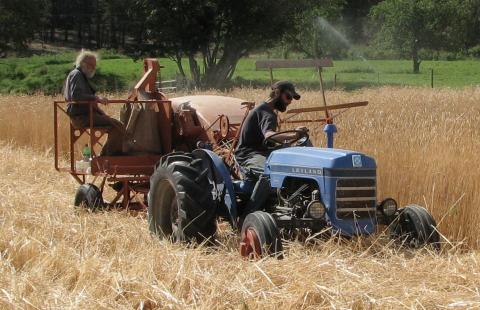***IF YOU HAVEN'T ALREADY, BUY THE SEED (the "Loto" for sure, and the "M-101" if you want) ON OUR ONLINE SEED STORE AT WWW.EFNSEEDS.COM IN THE GRAINS SECTION. DO THIS ASAP, AS MID TO LATE APRIL IS THE TIME TO START THESE RICE VARIETIES.
Note:
Sylvia Davatz has been saving seed and experimenting with useful plants for over 20 years. We collaborated on designing this project together. We ran the project last year (2018), with some success (and plenty of failure), but we are going to keep on keeping on. We are looking to get good data on this "Loto" rice variety, and we are especially trying to test how far north is can successfully be grown.
Description:
Upland rice does not require a paddy for cultivation, making it an excellent candidate for growing in the field or in a home garden. It is grown in moderately fertile garden soil without the need for more irrigation than other grain or vegetable crops. "Loto" is a cultivar from the Emilia-Romagna region in Italy. It is grown in the Italian-language canton of southern Switzerland, making it the northern-most rice cultivation in Europe. It has now been grown for several years in Vermont, indicating that it can thrive even in the US Northeast.
The purpose of this project is to evaluate the potential for the organic cultivation of Loto in northern regions, and it's ability to be a reliable crop for the home garden or small-scale commercial growing.
Farmers, homesteaders, and smaller-scale growers are invited to participate. We are hoping for about 20 participants in the project, mainly from more northern regions of the country, but no colder than Zone 4b. However, we won’t turn down growers from other parts of the country. Ideal growers have some gardening experience, although you do not need to have grown rice before. Our cut-off date for signing up for the project is Sunday, March 18th (2018).
To join you will first need to create a profile on this website, and then join the project. We'll contact you, confirming your interest in participating. Then, around mid March we'll send you seed, detailed growing instructions, and an observation form which you'll be asked to fill out and return to us by the end of the season.
We ask you to commit to growing at least 20 plants and to keeping careful records of specific data, for instance your USDA zone, soil type, growing methods (organic is preferred), harvesting methods, and yield, as well as dates to flowering, maturity, and harvest. We have a google form made up, so you can get familiar with the data we are asking you to take now: https://docs.google.com/forms/u/1/d/1AgNOpttwoqQyl84tnhXcV1c1OP0NMYa9i4g1pI0Akkc/edit?usp=drive_web





